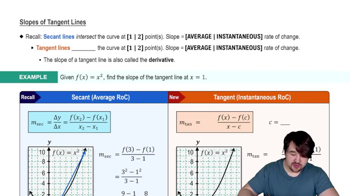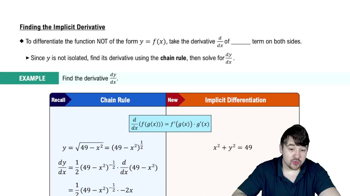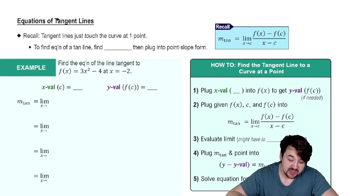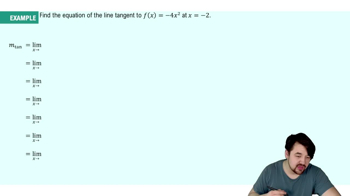Table of contents
- 0. Functions7h 52m
- Introduction to Functions16m
- Piecewise Functions10m
- Properties of Functions9m
- Common Functions1h 8m
- Transformations5m
- Combining Functions27m
- Exponent rules32m
- Exponential Functions28m
- Logarithmic Functions24m
- Properties of Logarithms34m
- Exponential & Logarithmic Equations35m
- Introduction to Trigonometric Functions38m
- Graphs of Trigonometric Functions44m
- Trigonometric Identities47m
- Inverse Trigonometric Functions48m
- 1. Limits and Continuity2h 2m
- 2. Intro to Derivatives1h 33m
- 3. Techniques of Differentiation3h 18m
- 4. Applications of Derivatives2h 38m
- 5. Graphical Applications of Derivatives6h 2m
- 6. Derivatives of Inverse, Exponential, & Logarithmic Functions2h 37m
- 7. Antiderivatives & Indefinite Integrals1h 26m
- 8. Definite Integrals4h 44m
- 9. Graphical Applications of Integrals2h 27m
- 10. Physics Applications of Integrals 2h 22m
2. Intro to Derivatives
Tangent Lines and Derivatives
Problem 3.8.82b
Textbook Question
79–82. {Use of Tech} Visualizing tangent and normal lines
b. Graph the tangent and normal lines on the given graph.
(x²+y²)² = 25/3 (x²-y²); (x0,y0) = (2,-1) (lemniscate of Bernoulli)
 Verified step by step guidance
Verified step by step guidance1
First, understand the given equation: \((x^2 + y^2)^2 = \frac{25}{3} (x^2 - y^2)\). This is the equation of a lemniscate of Bernoulli, a type of figure-eight curve.
To find the tangent line at the point \((x_0, y_0) = (2, -1)\), we need to differentiate the given equation implicitly with respect to \(x\). This involves using the chain rule and product rule.
After differentiating, substitute \(x = 2\) and \(y = -1\) into the derivative to find the slope of the tangent line at this point.
Use the point-slope form of a line, \(y - y_1 = m(x - x_1)\), where \(m\) is the slope found in the previous step, and \((x_1, y_1) = (2, -1)\), to write the equation of the tangent line.
The normal line is perpendicular to the tangent line. Therefore, its slope is the negative reciprocal of the tangent line's slope. Use the point-slope form again with this new slope to find the equation of the normal line.
 Verified video answer for a similar problem:
Verified video answer for a similar problem:This video solution was recommended by our tutors as helpful for the problem above
Video duration:
10mPlay a video:
Was this helpful?
Key Concepts
Here are the essential concepts you must grasp in order to answer the question correctly.
Tangent Line
A tangent line to a curve at a given point is a straight line that touches the curve at that point without crossing it. The slope of the tangent line represents the instantaneous rate of change of the function at that point, which can be found using the derivative. For the given curve, the tangent line can be determined by calculating the derivative of the implicit function at the specified point (2, -1).
Recommended video:

Slopes of Tangent Lines
Normal Line
The normal line is perpendicular to the tangent line at a given point on a curve. Its slope is the negative reciprocal of the slope of the tangent line. To graph the normal line, one must first find the slope of the tangent line at the point of interest and then use this slope to determine the equation of the normal line, which will intersect the curve at the same point.
Recommended video:

Slopes of Tangent Lines
Implicit Differentiation
Implicit differentiation is a technique used to find the derivative of a function defined implicitly by an equation involving both x and y. In this case, the equation (x²+y²)² = 25/3 (x²-y²) defines y as a function of x. By differentiating both sides with respect to x and applying the chain rule, one can find dy/dx, which is essential for determining the slopes of the tangent and normal lines.
Recommended video:

Finding The Implicit Derivative

 5:13m
5:13mWatch next
Master Slopes of Tangent Lines with a bite sized video explanation from Nick
Start learningRelated Videos
Related Practice



